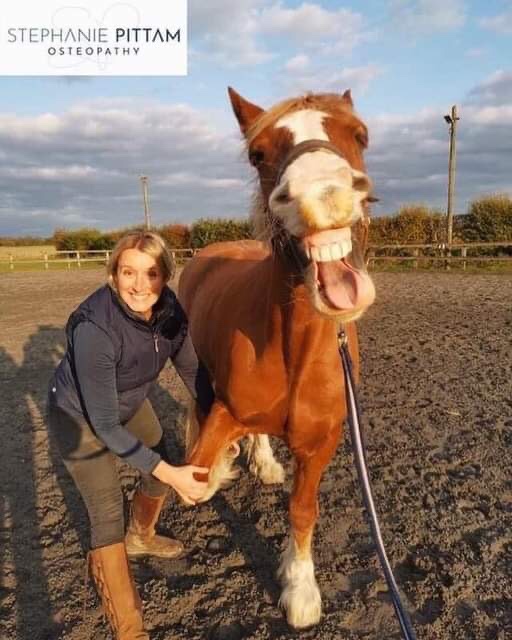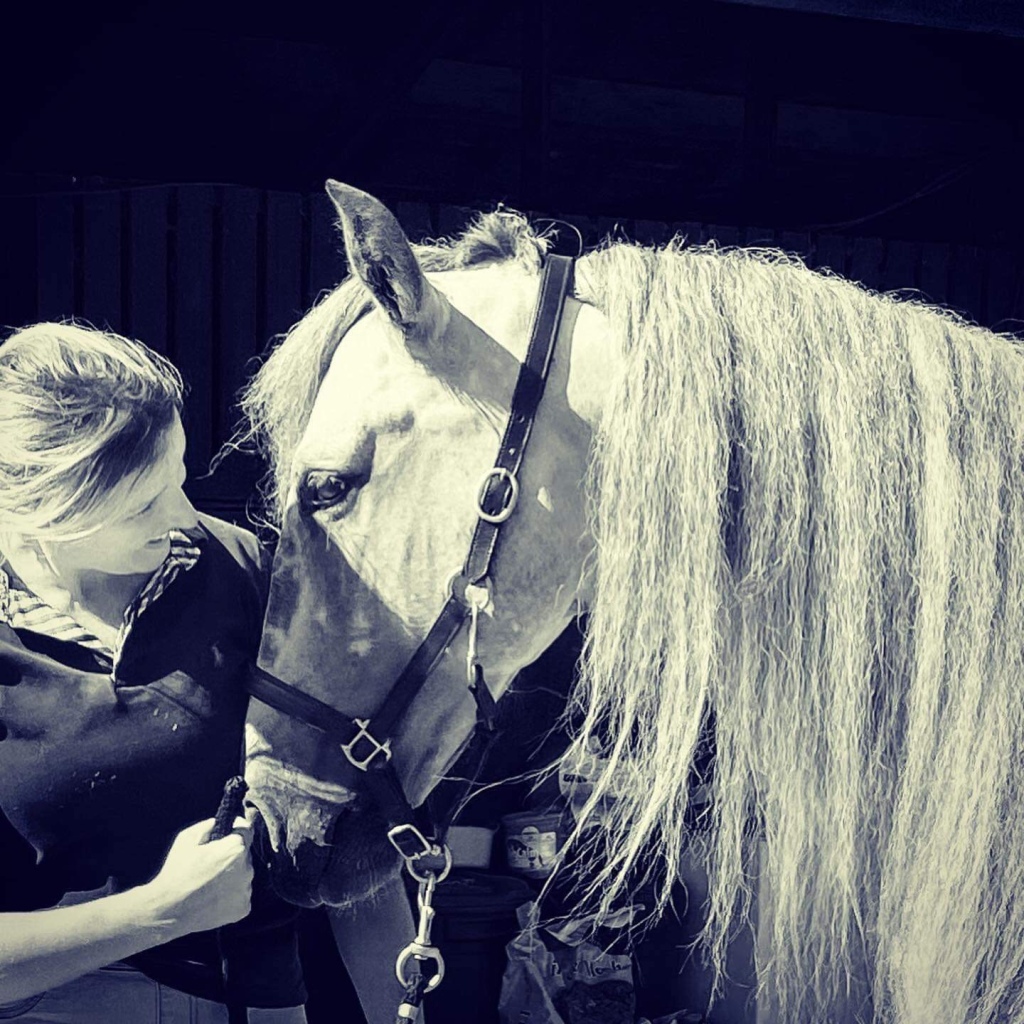Hello! I’m Stephanie Pittam, a Registered Osteopath for humans and animals based in Kent, UK. The majority of my work is with equine patients – over the past decade I have treated horses from all disciplines and with a huge variety of conditions, from the straightforward to the obscure. I am dedicated to getting to the root cause of a horses problem, and often work with other professionals such as trainers, vets, nutritionists and hoof care practitioners to help the horse function optimally.

As an Osteopath, I am concerned with how the body moves, and helping it to function to the best of its ability. Barriers to optimal health and wellness that I often see in human and equine patients include both physical and emotional stress, as well as injury, inappropriate diet, lack of movement and poor mental stimulation. My professions founding principle of ‘The Body is a Unit’ has never been more apt: True health cannot exist without complete harmony of mind, body and spirit.
Forage, Freedom and Friends.
The horse’s basic needs are more than just needing food and water. The ideal state for a horse is the freedom to roam and socialise, and to graze a range of forages within the safety of a herd environment. The need to move, graze and socialise is hard wired into their very being through millions of years of evolution. But how does a traditional yard set up accommodate those needs? And why are those needs important for all owners to consider? Because they will be stressed, physiologically and psychologically, to some degree, if they are not met.

In the midst of an extremely wet and miserable winter, one of the biggest challenges to equine health that I see is stable confinement and reduced or no turnout. For some horses, this is a year round lifestyle. In addition, turnout on ground that is poached, with no shelter or grazing, where the horse stands for hours at the gate is equally a problem. This is in direct conflict with the needs of the horse as described above.Conditions such as ulcers, colic, subcutaneous oedema (puffy legs), respiratory disease, obesity, thrush and stereotypical behaviours are rife and tend to increase with less movement. There are a million supplements, lotions and potions on the market to treat these conditions – but surely it would be better to prevent them happening in the first place by addressing the basic needs and environment of the horse? I feel we are becoming too used to seeing horses at a sub-optimal level of health, whether that is with poor hoof balance and health, incorrect weight, or displaying stress related behaviours. Unfortunately I see these issues very commonly in my patients.
‘Let your horse be a horse.’
It can be difficult for many owners to achieve a more ‘natural’lifestyle for their equine friend due to, for example, yard rules,or lack of grazing. I would urge owners to be creative in approaching this: remember that your horse is a living, sentient being. Enriching your horse’s environment will have a hugely beneficial impact on his mental state and overall health. If your horse’s needs are not being met, his system will be under stress and more prone to illness and injury. A study by Logan et al (2019) found that stabling negatively impacts bone formation in horses regardless of age. This is a very important aspect to consider when devising a management plan for your horse!

Remember, allowing a natural lifestyle does not necessarily mean turning your expensive competition horse out naked, in an acre of swamp with no grass. It is exploring ways in which you can meet the needs as described above. I understand not all owners have access to a naturally orientated livery set up such as at Graveney. However, there are still things you can do! On a competition yard I visit, if the weather does not permit turnout, the horses are hand walked and grazed in a safe environment twice a day, turned out to roll in a sandpit, allowed to groom and contact the horses in adjoining stables as well as being hacked or schooled. This is better than being shut in for 23 hours and only brought out to be ridden, but still some way off the ideal for the horse.
Osteopathically, the issues I see from restricting horse’s innate needs are multiple. For example:• Repetitive strain and soft tissue injuries from for example, weaving, box walking, door banging• Thrush causing low grade lameness• Back pain as a result of ulcers• Joint stiffness and swelling from a lack of movement• Stress causing generalised inflammation and tissue irritation
From my own personal experience treating horses, I see stress manifest itself in the body through numerous psycho-somatic mechanisms. I see thoracic (under the saddle) tension, ribcage rigidity, hypersensitivity to pressure, lack of body awareness, upper neck irritability, poor cranio-sacral rhythm – to name but a few! Symptoms and findings will be different for each horse. We need to start addressing the cause of these problems and not just the symptoms, however hard that might be. Anthromorphism happens commonly in the equine world, but please don’t assume that your horse sees his environment as you do! A ‘duvet day’ standing in a box eating might sound quite nice to a person on a cold wet day, but remember that your horse would more likely want to have a mooch around, good leg stretch, a roll in some mud and a groom with a buddy.
Recently, I read a post on a local Facebook group from a person asking for ideas to stop her horse banging the stable door. Door banging damages property, is annoying and can injure the horse’s limbs. The answers gave a really interesting insight into peoples’ perceptions of appropriate horse care: popular responses were to use various aversive techniques such as electric shocks or water sprays. The one person who suggested looking at why he was doing it in the first place was quickly shouted down, accused of being a ‘pony-patter’ and had their knowledge and skills belittled. Who was right from a behavioural science, ethical and welfare point of view? This is where traditionalism meets modern science, and sadly not all have the ability to change their ways of thinking.
Research has shown that horse owners commonly “fail to recognise, and consequently neglect to resolve, equine behavioural signs of distress, worsening the welfare of the horse” (Bell et al, 2019). I feel like this is a wake-up call; as owners we all want to have happy, healthy horses but we may be missing the mark in assessing our own horse’s mental state!

Natural horse keeping is a topic close to my heart. I have 2 horses; one of which is a retired dressage horse who lives free to roam with a herd in 1200 acres of organic ancient pasture. Living the dream! The complaints that dogged us in his ridden career are no longer a problem – weaving, box walking, separation anxiety, ulcers, forelimb lameness are a thing of the past all down to the drastic change in environment. He is a happier and healthier horse at 23 than he was as a 6 year old due to his needs of Forage, Friends and Freedom being met.
Of course, we don’t all have access to this kind of facility BUT I am seeing a growing trend in horse owners wanting to keep their horse in a more natural state. This is great news! A one-size-fits-all approach does not work, each horse and owner need to take into account their individual needs. As an industry I feel as though the equine world has one hoof still firmly planted in traditional methods, some of which have their place, but progress is being made into gaining a better understanding of our horses’ psychological and physiological needs. It will mean the difference between your horse surviving or thriving. In the words of David Mellor (2016),give your horse ‘A Life Worth Living’.

Bell, C., Rogers, S., Taylor, T., Busby, D. (2019) Improving the Recognition of Equine Affective States Animals 2019, 9(12), 1124; https://doi.org/10.3390/ani9121124
Logan, A.A.; Nielsen, B.D.; Sehl, R.; Jones, E.; Robison, C.I.; Pease, A.P.(2019) Comparative Exercise Physiology, 15 (4) 283-290 DOI: https://doi.org/10.3920/CEP190038
Mellor, D.,(2016) Updating Animal Welfare Thinking: Moving beyond the “Five Freedoms” towards “A Life Worth Living” Animals, 6 (3), 21; https://doi.org/10.3390/ani6030021